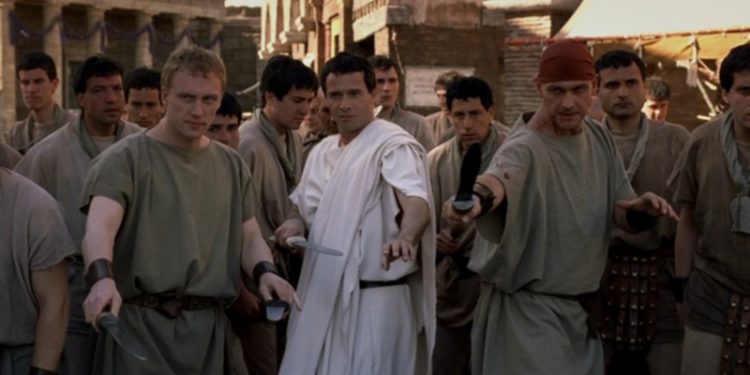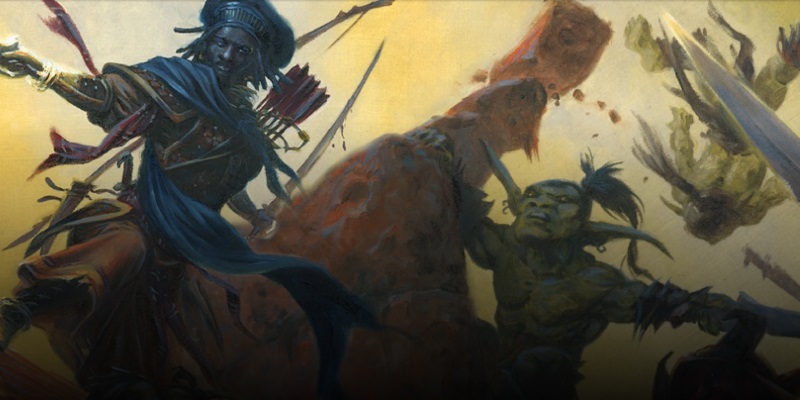The Fighter Class, Part Twelve

As I’ve said in the past several articles of this series, I thought I wanted to pair Dungeon World with another game’s fighter to have enough to talk about. Then I read the Dungeon World fighter playbook, remembered how much I like it, and decided that I’d just cover each feature.
Part One | Part Two | Part Three | Part Four | Part Five | Part Six | Part Seven | Part Eight | Part Nine| Part Ten | Part Eleven | Part Twelve
Dungeon World
Though I’ve covered DW a few times before, I don’t think I explained why it’s specifically relevant in the history of classes. For one, it’s a great counterpoint to 13th Age, because their menu-style classes have a lot in common. More than that, though, DW uses modern, clean mechanics to get to the most essential stories, the most exciting elements, of the classes and fantasy adventure. D&D influences word choice in some feature names, as you’ll see – let’s call it an incantation to summon Gygax into a younger body.
- Fighters can be dwarves, elves, humans, or halflings. DW wants to get to the most archetypal class/race pairings, but fighters have an archetypal pairing with most races. Because fighter. Each race offers a different minor feature.
- Dwarves, funny enough, get an improved social-interaction feature. It lets them put more emphasis on Con while still doing well in social scenes.
- Elves can add the Precise tag to any weapon – what 5e calls Finesse.
- Halflings get a bonus when their small size is useful. A +1 bonus means a lot more with a 2-12 bell curve probability spread.
- Humans are lucky – they can force a single damage roll to be rerolled once per battle. With very limited hit point totals for both PCs and NPCs, this could be a bigger swing to a fight than it might sound like.
- 10 + Constitution score hit points. That’s the largest hit point total of any class, by 2, and with non-scaling hit points, that means a little more than it sounds like.
- The counterpoint to the Everyman theme is the Shockingly Durable theme.
- Fighters deal a base of d10 damage.
- Damage is linked to class rather than equipment (mostly); DW doesn’t have a chart of weapons and how much damage they deal. It’s a choice that short-circuits a lot of design guesswork. The weapon chart does assign ranges and a few other tags to each weapon, though. There are a number of optional damage-increasing features, below.
- Bend Bars, Lift Gates expresses the raw might and non-combat destructive potential of the fighter. Even the halfling ones – though if you’ve dumped Str in favor of Dex as an elf, it’s going to be a tougher roll.
- Armored lets you move more gracefully in armor by removing the Clumsy tag. This is the narrative, rather than mathematical, way to say that you ignore armor check penalties.
- Signature Weapon lets you take a weapon and add on more features. You choose two features from a list and add them to the existing chassis of a weapon, possibly granting mechanical weight to your mental image of your character. It’s interesting that there aren’t any ranged options. Anyway, it’s a great list and full of character.
- Alignments for the fighter (each class has a limited number of alignments, and an alignment is a single element such as Lawful or Good) center on decisions in combat. Fulfilling to terms of your alignment grants you 1 XP at the end of the session.
- As a note to a friend of mine who had an odd experience with DW, fulfilling your alignment directive only pays once per session, according to the text.
- Gear and the choices you can make here tell a bit of a story as well – two picks from the gear list leaves you with two things not picked, and what you don’t take will definitely sting. Do you start out ready to adventure and destitute, or with a bit of cash but no healing potions tucked away?
- I do encourage alternate, more involved starting gear for 5e.
Beyond this we get into Advanced Moves. You pick one per level from 2nd to 5th. From 6th to 10th, you get a second list of choices.
- Merciless adds +1d4 to your damage. Because this is DW, the name of the feature also signifies the implied story element – it may not be spelled out that you are now sans merci, but you should strongly consider it.
- I am not an authority on interpreting DW rules; this is a layman’s opinion.
- Heirloom awakens the spirits that reside within your weapon, and they act as a source of information. Because why shouldn’t fighters have their own means of gathering information, and why shouldn’t it involve chatting with your Compensator? (Barbed for their pleasure destruction.) Also, this is a decent reason not to dump Charisma.
- Armor Mastery lets you take all of the damage of an attack on your armor or shield. This degrades the armor or shield by 1 point, destroying the item if it falls to 0. This is, in essence, the Shields Shall Be Splintered rule (a common OSR houserule) translated into DW. This is potent, but you’ve got to be ready to go without armor or replace it quickly. There aren’t explicit repair rules, but I think DW expects the GM to just… figure it out.
- Improved Weapon grants another extra feature to your weapon. You’re on your own for the story of how it gets there, but that’s fine.
- Seeing Red makes you better at gathering information during combat. I get an Eliot Spencer vibe off this – if you see how someone fights, you learn a lot about their background, and your alert mind helps you draw connections quickly.
- Interrogator lets you use Strength rather than Charisma when violence is the leverage you use in a parley. I’ve never been completely comfortable with letting people do so for free, but paying a feature pick for it is fine. When it’s free, it’s another excuse for fighters to treat Charisma as a dump stat.
- Scent of Blood adds +1d4 to your damage the next time you damage someone, after using the Hack and Slash move. Unless I’m missing something, you probably want this to be your second pick after Merciless, but getting to a 1d10+2d4+2 damage round would be devastating.
- Multiclass Dabbler lets you pick a move from another class. I’d suggest that this is a little bit of an Everyman story and a little bit of a nod to fighters being allowed to multiclass with anything in 1e/2e. Incidentally, a feature like this is available to every playbook in Apocalypse World, but it’s unique to fighters in DW.
- Iron Hide grants +1 armor. This armor value doesn’t seem to be part of your existing armor or shield, so it doesn’t stack for purposes of Armor Mastery.
- Blacksmith lets you destroy a magic weapon to add its power to your own. Probably not a necessary first pick, but nice to have all the same.
The rest of the options require you to be 6th-10th level:
- Bloodthirsty upgrades Merciless to +1d8.
- Armored Perfection upgrades Armor Mastery by giving you +1 forward (that is, +1 to the next thing you do) against the person who damaged your gear.
- Evil Eye requires Seeing Red, but its story is much more about intimidation in combat. It doesn’t take a huge stretch to see Cú Chulainn’s warp-frenzy here, but it’s also not 1:1. One huge thing about this move is that its 6- result may still be something that you want, which is not common in DW.
- Taste of Blood upgrades Scent of Blood to +1d8. For peak damage, you’re looking at spending 4 of your 9 advancements, but that is a phenomenal amount of damage in this system – an average of something like 16.5 damage, if you focus on damage as much as possible.
- Multiclass Initiate continues the Multiclass Dabbler concept.
- Steel Hide replaces Iron Hide, for another point of armor. Did we mention that you’re super duper tough? By this point you could be completely shrugging off a lot of Harm – 2 from scale armor, 1 from your shield, and 2 from Steel Hide is big.
- Through Death’s Eyes is a narrative-control feature, of a kind we haven’t otherwise seen in the fighter. Its story pushes the class toward “angel of death.” I love this mystical conception of the fighter, as someone who has a close spiritual connection to violence and death.
- Eye for Weaponry lets you ask the GM about the damage dice your opponents use. That’s pretty neat, though I’m not sure it’s worth the cost of an advancement to me. What does knowing that get you, in terms of later decisions?
- Superior Warrior gives you a 12+ outcome on Hack and Slash, a yes-and-and that adds impressing, dismaying, or frightening your enemy to the deal. You’re not going to hit a 12+ all that often, but when it hits, you do it with All the Panache. Watching a fighter at the top of their game should be discouraging to enemies.
There are a lot of story elements here to cover the fighter. This isn’t an ideal class for a duelist or swashbuckler (because life without armor is hard), but a graceful-in-armor combatant is well-supported here, especially as an elf. To everyone else, you look superhumanly tough, even more so if you build it up. I love love love the social interaction, investigative, and exploration features. Fighters can use the Spout Lore, Discern Realities, and Parley moves just like anyone else, but the options to expand these in a more fighter-y direction are great.
To characterize it all in a single phrase, though, it’s about being married to death – most of the class’s advancements are about the erosion of your humanity (i.e., ability to be humane, not your state of being a human). This doesn’t push you toward the laughing warrior, such as Conan with his “gigantic melancholies and gigantic mirth.” To be clear, it doesn’t block you off from playing that type of character – you can always pick advancements that emphasize other things. It’s much more about bloodshed as a way of life and having a bond with one signature weapon.
Next time in the History of the Fighter: 13th Age.



